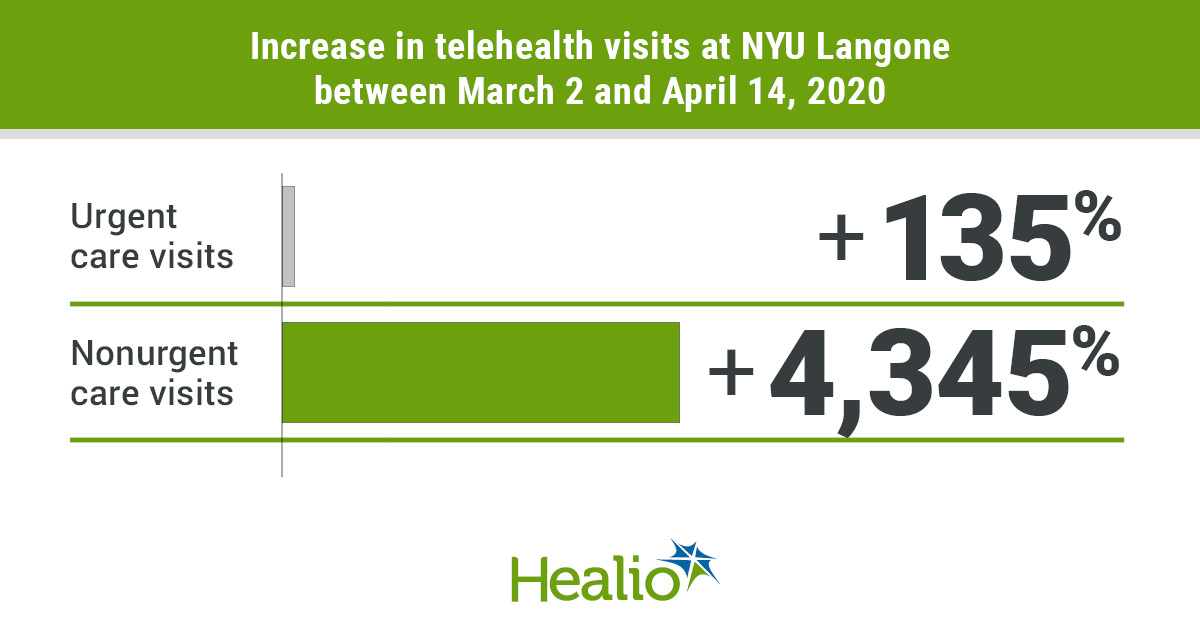Q&A: Addressing the explosive growth of telehealth use amid COVID-19

Approximately one in 10 Americans used telehealth as an alternative to in-person visits to doctor’s offices, urgent care centers and EDs, according to a survey published last year. However, it was not until the COVID-19 pandemic that the uptake of telehealth dramatically changed, an expert told Healio Primary Care.
Joseph C. Kvedar, MD, president-elect of the American Telemedicine Association, said his health system — Partners HealthCare in Boston, which includes Brigham and Women’s Hospital and Massachusetts General Hospital — used telehealth for medical office visits less than 2,000 times in February 2020. Two months later, monthly telehealth office visits approached a quarter million.
“There's no superlative I can apply to it,” he said.
The surge is not limited to Boston. Other data show that between March 2 and April 14, 2020, urgent care visits conducted via telehealth at NYU Langone increased 135%. Nonurgent care telehealth visits skyrocketed 4,345%, according to researchers.

HHS has observed a surge in telehealth use on a national level.
“When you look at telehealth in just the last month and a half or so, we’ve leaped about 7 or 8 years into the future,” Eric D. Hargan, JD, deputy secretary of HHS, said in an April 22 conference call with reporters.
Healio Primary Care spoke with Kvedar about how physicians in both urban and rural areas can choose a telehealth vendor that will be a partner long after the pandemic subsides, how to ensure telehealth systems meet HIPAA requirements, and more. - by Janel Miller
Q: How is the COVID-19 pandemic changing the landscape of telehealth?
A: In February, we did about 1,600 virtual encounters at Partners HealthCare affiliated hospitals. In March, we did 89,000 and in April, we did 240,000. Every other health delivery system that I have canvassed over the last few weeks has had a similar story. That tells the story. It is extraordinary.
This growth has made living rooms work for both patients and clinicians. Telemedicine is on the news, the subject of people’s chats, social media pages, etc. I have been at this almost 30 years. It never was this way until now. It has been dramatic.
Q: What should a physician consider when choosing a telehealth vendor for the long term, not just during the COVID-19 pandemic?
A: Relaxed restrictions are allowing people use Skype, FaceTime, Google Hangouts and pretty much anything for telehealth right now.
But in the long term, to ensure privacy and security, the vendor’s telehealth services should integrate into a physician’s electronic medical record system. There is probably some software that must be built, and that takes longer, but doing so is more efficient for you that way and more secure.
Q: What are some of the regional differences that need to be considered when deciding whether physicians should go the telehealth route? How can telehealth be practiced in areas with limited internet access?
A: This is a very important issue and is the reason why there was such a strong advocacy effort to get telephone calls paid for during the pandemic.
Traditionally, Medicare and insurance companies did not pay for phone calls. Patients would come see us in the office. Then if a patient had to be contacted for something, such as a question about a medicine, payers would say that the interaction was bundled into the office visit payment. During the pandemic, this has all gone away. Payers are reimbursing for telephone calls at the same rate as an office visit. We expect that there will be some capability to do this work in the long run over the telephone, and although that sometimes limits what we can do with the patient, it's better to have a phone conversation than to have no care at all.
Q: What are some of the essential components that a telehealth platform must provide? What components might be considered unnecessary add-ons?
A: Besides the electronic medical record integration that I talked about earlier, physicians should be able to schedule telehealth encounters, launch a video call easily and connect with patients through an online portal. The patient having blood pressure cuffs and glucose monitors at home are nice things to have, but they are not must-haves.
Physicians need to think very carefully about what they are going to use telehealth for, so that they do not create unnecessary expenses by adding technology that has the potential to go unused or not integrate properly into their systems.
Q: What is the average cost of implementing telehealth in private practices?
A: The cost of implementation is highly variable. While some platforms are free, they are relatively limited in what you can do. These free platforms also probably do not have the right level of security for health care use.
Q: Which HIPPA-compliant telehealth platforms do you recommend and why?
A: The EMR vendor Epic’s website lists five or six recommended vendors.
The important thing for physicians to remember is that the platform they choose needs to pass a security audit and integrate into whatever electronic medical record system they are using.
References: J.D. Power. U.S. telehealth satisfaction study. https://www.jdpower.com/business/healthcare/us-telehealth-satisfaction-study. Accessed May 20, 2020.
Mann DM, et al. J Am Med Inform Assoc. 2020;doi:10.1093/jamia/ocaa072.
Disclosures: Hargan is deputy secretary at HHS. Kvedar reports no relevant financial disclosures.

